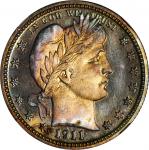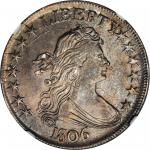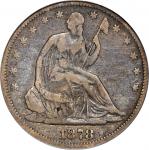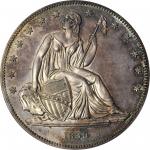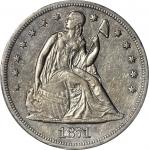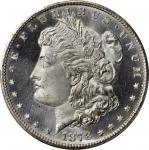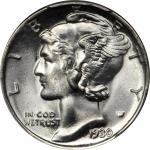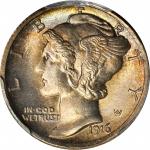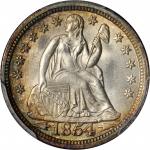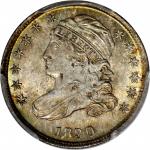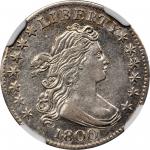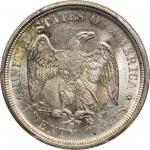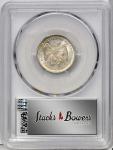1875-S Twenty-Cent Piece. BF-11. Rarity-3. Misplaced Date. MS-67 (PCGS).Exquisite Superb Gem quality for this brief and conditionally challenging odd denomination series from the 19th century. Billowy mint luster flows serenely over surfaces that are at the threshold of numismatic perfection. Striking detail is razor sharp to full over virtually all design elements. The obverse is brilliant, but close inspection of the reverse reveals wisps of charming powder blue, pale pink and golden-olive iridescence. A delight to behold, and undeniably rare from a condition standpoint, this coin would serve as a focal point in the finest type set. Authorized by the Act of March 3, 1875, the twenty-cent piece came to fruition largely through the efforts of Senator John Percival Jones of Nevada. Representing Western silver mining interests, Jones saw the twenty-cent piece as another outlet for the mine owners product, one that would require the United States Mint to purchase more of their precious metal for coinage operations. Western mine owners certainly had reason to fear the possibility of falling silver prices during the 1870s. In the United States, the Act of February 12, 1873 (the so-called "Crime of 73") abolished both the silver half dime and silver dollar. Although the act simultaneously authorized the new trade dollar for international commerce with the Orient, the perception was that the Mint would need less silver for coinage now that production of the domestically used half dime and silver dollar had been halted. Events on the world stage at that time were equally disturbing, with the newly unified German Empire adopting the gold standard and demonetizing silver. Since the United States Mint was actually the largest purchaser of silver in the world during the 1870s, Senator Jones and other like-minded individuals surmised that the best way to protect silver mining interests was to force that institution to purchase as much of the white precious metal as possible. In order to sell Congress and, indeed, the nation as a whole on the need for a twenty-cent piece, however, Jones told the story of unfortunate patrons in the Western United States being cheated by merchants due to a lack of small denomination coins in circulation. By the mid 1870s the Spanish "bit," or one-eighth of an 8 reales, although nominally valued at 12.5 cents, had become equivalent to a United States dime in the Western part of the country. With a shortage of five-cent coins in circulation in the West at that time, however, a customer offering a quarter dollar for a "bit" purchase received only a dime in change, thereby being forced to pay 15 cents for a 10 cent purchase. According to Senator Jones, a twenty-cent piece would return fairness to such transactions, allowing the patron to make their "bit" purchase with the new coin and receive the proper change in the form of a dime. As with all such stories, there was a kernel of truth to what Senator Jones was saying. The United States Mint would no longer be producing the silver half dime in the wake of the Act of February 12, 1873. Furthermore, the nickel five-cent piece was not seen in the West since only gold and silver coins circulated in that part of the country. The notion that a twenty-cent piece would protect the interests of patrons in the West became the rallying cry for those advocating for the denomination. This idea even found expression in the contemporary book <em>History of the Big Bonanza</em> by Dan De Quille, the <em>nom de plume</em> of William Wright, an author and humorist living in Virginia City, Nevada. Published in 1876, the book included the following passage about the twenty-cent piece, as quoted in the 2014 reference <em>Double Dimes</em> by Lane J. Brunner and John M. Frost:"The money in circulation is wholly gold and silver coin, and the smallest coin in use is the bit, ten-cent piece -- sometimes spoken of as a short bit, as not being twelve and one-half cents, the long bit. There being no smaller change in use than the dime, the bit passes for the half of twenty-five cents. Thus, whenever a customer throws down a quarter of a dollar in payment for a drink or a cigar, he gets back a dime, and so has paid fifteen cents for his nip or smoke. The new twenty-cent pieces, of which Senator Jones, of Nevada, is the father, will, however, cure this little ill. In the two-bit, or twenty-five cent saloons, everything is twenty-five cents, even the same drinks that are sold in the git houses for ten cents; as lager beer, soda water, lemonade, cider, and the like."In reality, however, Jones story is just that -- a story. According to Brunner and Frost, there is no real evidence that the average customer-merchant transaction in the West during the 1870s suffered either through a shortage of five-cent coins or the lack of a twenty-cent piece. And it is probably just as well, for the twenty-cent piece proved to be a failure as a circulating medium of exchange. Coinage for the new denomination began in 1875 at the Philadelphia, Carson City and, especially, San Francisco mints. From the start, however, it was apparent that the twenty-cent piece as a circulating denomination had problems. The size and design were too similar to those of the quarter dollar for the twenty-cent piece to be useful in the Western states. In the East, where minor coinage and paper money were already widely in use, a coin denominated as twenty-cents was simply not needed. Limited circulation strike deliveries followed from the Philadelphia and Carson City mints in 1876, after which no more examples of this type were produced for commercial use. Proof coinage, which commenced in 1875 with the authorization of the denomination, continued through 1878, that year finally seeing the last of twenty-cent piece production. At 1,155,000 pieces produced, the 1875-S has the highest mintage in the brief twenty-cent series. It is by far the most plentiful issue of this denomination in todays market, and is the quintessential type candidate for the collector seeking a single example of the twenty-cent piece. Perhaps interestingly for a denomination that proved such a failure in commerce, most 1875-S twenty-cent pieces in numismatic hands are worn, often to a considerable extent. Yet even so, Mint State survivors are plentiful enough that they are usually available in quantity in major auctions and at other large numismatic gatherings. On the other hand, this remarkable MS-67 is a noteworthy condition rarity that ranks among the finest known to PCGS. It is an awe-inspiring example of both the type and issue that is destined for inclusion in a world-class cabinet.PCGS Population: 5; with a single MS-68 finer for the issue. PCGS Population: 10; 2 finer for the type as a whole (MS-68 finest)



